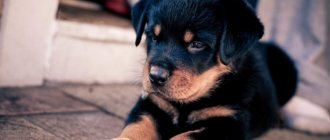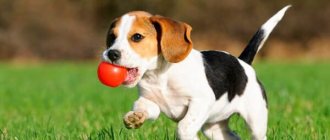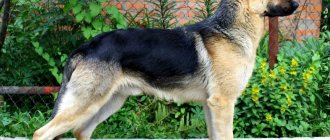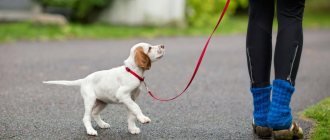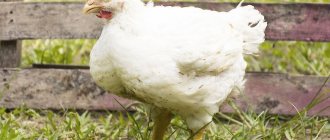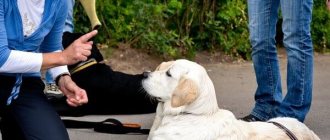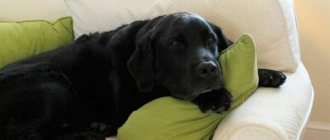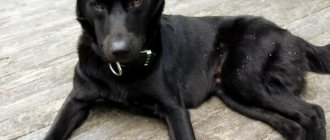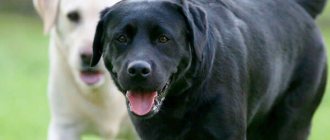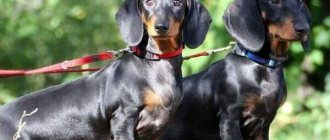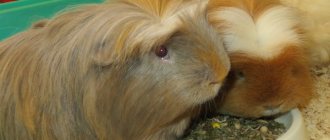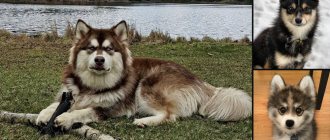The question of how to raise a Labrador puppy cannot be given a definite answer. It all depends on what rules exist in your home. If you want to keep them, then you need to teach the dog these rules. And if you are not one of the people who adhere to a special order in everyday matters, then additional anxiety will not disturb you. But in any case, there are a number of things that a new tenant should know. They say that the appearance of an animal in the house disciplines the owner. So all changes in home life will be more likely to be for the better than for the worse. And our article will tell you about this in detail.
So as not to cry without mom
Raising Labrador puppies begins immediately after they are moved to a new home. The best age for a baby to change residence is one and a half to two months. If he has a calm psyche, which is typical for this breed, then his separation from his mother will be painless.
But there are times when a small Labrador, finding itself in an unusual environment, begins to whine. Give him maximum attention, distract him from anxious thoughts with a game or a treat. At this age, like a child, he gets tired quickly and sleeps a lot. However, now you need to accustom the puppy to the fact that you will not entertain him all day. Therefore, try to immediately leave the baby alone as soon as he gets busy with something. Not for long, literally for a minute.
It is necessary to increase the time of his independent activities gradually. And very soon he will be completely alone. This advice is suitable for those who in the future do not intend to be in the company of their pet 24 hours a day. That is, for those who plan to go to work, visit or do other important things.
Briefly about the breed
Labradors stand out for their massiveness and proportionality. On average, dogs of this breed reach a height of at least 50 cm and a weight of more than 20 kg.
Their body is powerful and long with a voluminous chest and a wide head. The drooping ears are located slightly back, almost on the back of the head, and the almond-shaped eyes are set far back, which visually narrows the elongated muzzle.
The tail, thick at the base, gradually tapers and is almost always in a horizontal position.
Such a hard, dense and short coat was inherited from their ancestors living on the cold shores of Canada, and thanks to the well-developed undercoat, it reliably protects them from low temperatures.
Before getting a large pet, you should consider having a large empty space.
Numerous photographs of dogs show that Labradors prefer freedom of action, and better yet, constant exposure to nature.
Have pity on the ceremonial suit
Education and training are very close concepts. However, the second applies more to a dog that is already undergoing obedience training or acquiring some kind of working specialty. And education is some general rules that include the most basic skills:
- knowing your nickname;
- a designated place for the toilet;
- calm attitude towards the collar and leash;
- knowledge of the prohibition command;
- understanding the territory allowed for walking.
Often, ill-mannered dogs pick up food from the ground or beg from the table, annoying guests. It’s really bad when the dog doesn’t even know his place in the house and hangs around wherever he can. The result of the owner's negligence may be the pet's childhood habit of chewing shoes or tearing laundry off the lines in the yard.
To prevent anything like this from happening in the future, the owner of a Labrador Retriever must always remember: the funny puppy will grow up very soon. And everything that causes tenderness in childhood can later become a serious problem. After all, there is little joy in the fact that when you meet a loving dog weighing 50 kg, he puts his dirty paws on your chest, ruining your expensive clothes.
The main rule: decide what your dog will be allowed to do when he grows up. Based on this, build a pet training program.
Dangerous insects
After each walk, you need to inspect your pet's fur for ticks. By brushing your dog, you will remove not only loose hair, but also some of the attached insects. Ticks that have already sucked will fall off on their own. And those that hold tightly must be carefully removed.
Lubricate the tick with vegetable oil to limit its access to air. After 15-20 minutes it should fall off on its own. If this does not happen, then use tweezers or thread to pry the tick and begin to twist it out. Be careful that the insect's head does not remain in the skin. If you are not confident in your abilities, it is better to consult a doctor.
The presence of fleas in an animal is very easy to determine. Black crumbs (products of their vital activity) appear in the wool. And on the stomach, in the armpits or on the inside of the hind legs you can find bite marks in the form of red spots. Special sprays, powders, drops that can be found at the pharmacy will help get rid of fleas. Among domestic ones, these can be “Bars” or “BlochNet”, among imported and more expensive ones - “Frontline” or Hartz. It is necessary to treat not only the dog’s fur, but also the room where it lives, especially the kennel and rug.
Worthy of a treat
The very first command that the puppy must remember is “Place”. As soon as he crosses the threshold of the house and gets acquainted with the territory, you must immediately show him this place. It doesn’t matter whether it’s a bed in an apartment or an enclosure with a booth in the yard.
In the process of exploring new possessions, he himself will wander where he needs to go. Then, with a slight movement of your hand, hold it there for a while. At the same time, say the command: “Place” several times. In the future, these steps will need to be repeated several times a day.
If a new family member accidentally enters the prohibited territory, you need to take him to the place and repeat the command. Labradors are very intelligent. In just a few days, your dog will know that it is possible to go here and not to go there. Very soon he will learn to go “to himself” on his own on command.
Every correctly performed action needs to be reinforced with a treat. The puppy should have positive feelings associated with this command. Then he will love his own corner and will not lie around anywhere. If the Labrador were human, he would probably think: “I’m lying in my place and worthy of praise and treats.”
But not everything can always go smoothly. Be sure to be patient, do not get irritated or yell, and, moreover, never hit your pet. Such treatment can negate all your further efforts. Remember that a Labrador is a dog that is trying to understand what is required of it.
Training at 3 months. Socialization
Three months is an important stage in a Labrador puppy’s introduction to the outside world. Your first walks should be short and not too tiring for the puppy. You should start with 15 minutes, gradually increasing the walking time to 1 hour.
Correct formation of the nervous system
At this age, the puppy’s nervous system is forming.
. It has been proven that raising puppies in isolation during this important period contributed to the development of pronounced cowardice in them later. It is necessary to show the puppy as much as possible: noisy streets, large crowds of people, etc. Everything that he will have to face in later life.
This must be done very carefully, gradually, over and over again increasing the time spent in noisy places, so as not to overload the puppy or frighten him.
The territory of a country house, cottage or village are places with a minimum amount of external stimuli for a city dog. Therefore, if you plan to keep a dog in an urban environment, “growing up” a Labrador puppy in such conditions depleted of irritants is unacceptable.
A city puppy must grow up in the city, in conditions that are saturated with external stimuli, such as: noisy streets, large crowds of people, other animals, birds, cyclists, cars, etc.
Meeting people and dogs
It is necessary to introduce the puppy to friendly dogs and people
so that later the puppy does not develop aggression or cowardice caused by the fear of new things and the inability to communicate and make new acquaintances. Currently, unfortunately, this is not uncommon in the behavior of adult dogs, but a fairly common problem with which people turn to our specialists for help.
Puppy behavior on the street
The emergence of new places leads to new rules that need to be consolidated:
- Now you can and should go to the toilet on the street, and not stoically endure it, carrying everything home;
- Not every new person or dog wants to communicate, so you don’t need to run headlong to meet everyone;
- Not all food is healthy, so it should only be taken from the owner’s hands.
Training and practicing commands
Training a puppy follows the same principles as at 2 months. It should be remembered that at this age puppies develop conditioned reflexes quite easily, but they are forgotten just as quickly, so you should not scold the puppy for not following commands, especially if they have not been repeated for a long time, but you should pay more attention to learning new things and repeating already covered material .
I hear you, master
In parallel with the “Place” command, the baby is taught a name. He remembers it even faster. Whenever you call him to eat, play or go for a walk, call him by his name. It is desirable that it be short and sonorous. Some experts believe that cats love hissing sounds, and dogs love growling sounds. So, if your pet's name contains the sound "R", he will really like it.
During walks, call the puppy’s name and give him a treat. Thus, this word will always be associated with pleasant feelings for him.
Don’t let your nickname replace the command “Come to me!” in the future. When you call a dog by name, it does not have to immediately run up to you. The dog should simply turn his head in your direction, as if answering: “I hear you, master.” That is, you draw his attention to yourself to give the next command.
One more nuance. You shouldn't humanize your dog. No matter how smart she is, she is still an animal. Her mind is structured completely differently, and her upbringing is based on reflexes. Therefore, the dog perceives a distortion of its nickname or a change in the pronunciation of any command as a new word.
How to accustom to a home environment
In order for a brown Labrador puppy or any other puppy to feel comfortable, you should follow some steps:
- give him the opportunity to walk around the house, look and smell everything around him;
- It is not recommended to suddenly change the puppy’s usual diet; at first it is worth providing him with his usual food;
- When whining at night in the first days in a new place, there is no need to accustom him to your bed; it is enough to stay next to him on his bedding and hold your hand on the puppy;
- Give your baby toys and allocate some time for learning from the first days.
Important! To build a trusting relationship with a pet, the owner should not lock the dog and cause him inconvenience. After all, the puppy has a good memory and immediately understands the owner’s mood.
The touchy-feely are being re-educated.
Labrador is a very active breed. For good physical development, the puppy must exercise a lot. As he grows up, walks will provide an outlet for energy and keep his muscular core in the right shape. It is important that the dog learns how to behave in the company of people and animals. Then he will not create problems for you either in an open field or on city streets.
These issues can be easily resolved with the help of a collar and leash. The baby should also be accustomed to them gradually. First, a soft collar is put on him for a very short time. Not too tight or loose. Two fingers should fit freely between it and the pet’s neck.
Most often, he will not pay any attention to the fact that something is wrong with him. However, there are some Labradors who are touchy-feely, who express dissatisfaction and try to remove the extra item with their paws. In any case, after you put the collar on your puppy, you need to give him a treat and distract him with play. Gradually, the period of time in the collar should be increased. The time will come, and the dog will stop reacting to him altogether.
Nutrition
The basis of the diet of an adult representative of the breed is food rich in amino acids, complex carbohydrates and proteins. Such substances are present in cereals, meat and dairy products. In addition, a Labrador puppy should receive microelements contained in fruits, as well as vitamins found in vegetables. He will gain weight gradually. Let's consider a daily menu option for a baby retriever:
- Boiled cow's milk + 100 grams of raw chicken.
- Buckwheat with milk or cottage cheese.
- Boiled or steamed vegetables, such as peppers, broccoli and carrots.
- 100 grams of raw meat.
- Fruits, for example banana.
Cereals can be replaced with soup or broth. Gradually, the amount of food for the dog needs to be increased. This is required for the gradual growth of bones and muscles. An adult representative of the breed can be switched to premium dry food.
Their use of this product has a number of advantages. Firstly, the animal that consumes it will definitely be well-fed and healthy. Secondly, you won't have to cook for it often (trust me, you'll save a lot of time).
In addition, do not forget to treat your dog with berries. She really loves melon, watermelon or raspberries. Never give her spicy fish or chicken bones! They can get stuck in the animal's throat and even lead to its death. Also limit his consumption of processed meats, fatty and fried foods, and smoked foods.
Favorite outfit
The same training principle applies when hooking up the leash for the first time. Its length can be one and a half to two meters. At first, he simply reaches out for the running puppy and does not limit the movement in any way. You need to make sure that the leash does not accidentally get caught on something and there is no sudden jerk. This will scare the baby and cause him pain, which is extremely undesirable.
After just a couple of “free” walks, you can pick up the leash, gradually accustoming the puppy to some restrictions. This skill will help you with training in the future. And remember: never punish your dog with a leash.
If you do everything correctly, the Labrador will love its “outfit.” It will connect him with the upcoming walk. Seeing the leash and collar in your hands, the dog will express delight in anticipation of leaving the house. It happens that adult Labradors themselves bring their leash to the owner, inviting him to go for a walk.
Since we are talking about “uniform”, keep in mind that each dog should have: a soft collar, a short leash 1.5 - 2 meters long, a long leash (at least 10 meters), a muzzle, a strict collar (used for development of special skills), harness (if necessary), retrieval object (ball, rubber or wooden dumbbell).
Vaccination schedule and which ones should be done
To raise a healthy Labrador and avoid frequent visits to the veterinarian, it is necessary to vaccinate the animal against all kinds of diseases on time.
Mandatory vaccinations for a Labrador in the first year of life:
- plague of carnivores (distemper);
- parvovirus enteritis;
- parainfluenza;
- rabies;
- infectious hepatitis;
- leptospirosis;
- trichophytosis;
- microsporia.
The first vaccination against plague is given to an animal at 2 months of age. The vaccination is quite difficult to tolerate: with fever, general weakness and diarrhea. The second vaccination (also against plague) is administered after 3 weeks. This time the Labrador should feel lighter.
At 2.5-3 months, it is necessary to vaccinate the animal comprehensively (one vaccine includes drugs against several diseases at once).
At 4 months of age, the puppy is vaccinated against rabies and the complex vaccine against a group of diseases is repeated. If your baby's teeth change during this period, you should wait. In this case, all vaccinations are given to the Labrador at 5 months.
Popular articles Dogo Argentino (photo): handsome, brave hunter and protector
At 1 year of age, the dog is revaccinated against distemper, rabies and other unpleasant and dangerous diseases with a complex vaccination. These vaccinations must be repeated every year.
This sweet word "ha-a-a-rosho"
At the very beginning, we said that the appearance of a dog in the house disciplines its owner. This is true.
Firstly, he inevitably has to put things out of sight that he can steal and ruin in the game. This means that now they will all be in their places.
Secondly, whether you like it or not, you have to go for a walk with your beloved “child”. At least twice a day, morning and evening. As a result, along with the pet, the owner himself receives a boost of energy, seasoned with a portion of fresh air. Morning and evening exercise is good for the health of both.
Thirdly, the owner of the puppy begins to live according to the regime without noticing. And this is also a positive thing.
Now we’ll tell you some little secrets, knowledge of which will help in caring for and raising a new family member.
As a delicacy, you can use not only small pieces of meat and crackers cooked in the oven. You can please your dog during training with vitamins, which you will still give him throughout the day for proper development. But do not exceed the daily norm. You can also use dry food pellets. And even if the dog is not hungry, then receiving such a ball from the hands of his beloved owner is a great happiness for the Labrador.
You also need to praise your puppy correctly. There is a special command for this: “Okay.” You need to pronounce it drawlingly, affectionately and show your pleasure in every way. Labradors perfectly sense the intonation and mood of the owner. When he remembers this sweet word “ha-a-a-rasho”, the need for treats will disappear by half.
Labrador personality traits
A dog like a Labrador has a character that fully corresponds to the purpose of breeding - this is the character of a hunting dog, designed to track and pursue prey. He absolutely loves being in water - pools and ponds have an attractive force for him. Their active behavior is also based on the principles of hunting behavior.
Advertising:
Labradors are very loyal to their owners - such a dog is extremely attached to the owner and all family members. They are generous and practically devoid of selfishness. The habit of being happy for any reason can sometimes seem too intrusive and problematic, becoming a source of constant chaos in the house.
Labradors are very attached to their owners
However, at the same time, the Labrador is a loyal and loving friend who is always ready to help. As a watchdog, he is absolutely useless, since he welcomes the arrival of guests - for strangers he will be a friendly butler, and not a strict guard.
The puppy has a girl's memory
It is impossible to raise a Labrador puppy well without developing a reaction to prohibitions. Be sure that you are waiting for: shoes damaged by teeth, soiled things and puddles in the wrong place. In each specific case, you must know how to respond to your pet’s unwanted behavior. And you definitely need to teach him the “Fu!” command, which is given sharply and angrily.
Remember that you can only say it when you catch the puppy at the crime scene. For example, when he ruffles your favorite dress in front of your eyes (forgot to hide it in the closet) or breaks flowers, digging a hole in the front garden with his paws. These actions must be stopped immediately with a stern voice.
But if you find traces of bad behavior an hour later, then you should no longer scold him. Dogs have a very short memory, literally “girlish”. The puppy has long forgotten what he did, and your complaints will be incomprehensible to him.
As for unauthorized puddles and piles, there is no point in scolding them for them at all. The process of toilet training a Labrador puppy is a painstaking one, and success is entirely up to you. Usually he wants to do this immediately after sleep or after eating. Therefore, a baby who wakes up or has had lunch should be immediately taken to the designated toilet area. As soon as he does his job, he should be praised. As they grow older, the intervals between the appearance of puddles will become shorter. Watch your puppy carefully and catch the moment when he wants to go to the toilet.
Features of the first days of life
Preparation for proper puppy care should begin even before the baby arrives.
- Decide in advance where the pet will be located in the house. There should be no drafts, sharp corners or crevices nearby where the pet can crawl.
- Put away small items, jewelry, and medications that your baby might swallow.
- If the house has laminate or parquet, it is advisable to cover the floor with a carpet or runner at first.
- Immediately buy everything you need to care for your little Labrador: vitamins, food, brushes, toys, dishes, a collar with a leash, etc.
Like all puppies, Labradors are born blind, helpless, unable to independently regulate their body temperature and eliminate waste products.
Important! At these times, their mother is completely responsible for the life of the baby: she not only feeds, but also warms, and also stimulates the work of the small intestines with her caresses. Learn how to care for Dachshund, Chihuahua, and German Shepherd puppies.
It's unpleasant to sleep on thorns
Such a disadvantage in raising a dog as begging at the table will not be very pleasant. Therefore, from the very beginning, it is worth stopping all your pet’s attempts to beg for a tasty morsel at the moment when you and your family are having dinner. How to teach a puppy to order? The recipe here is simple. First, the dog should not be hungry. And secondly, no matter how much he looks into your eyes, under no circumstances give him anything. Be firm. The Labrador will quickly understand that it is useless to wriggle and flirt with its tail: it won’t give you anything anyway. Eventually he will simply stop asking for food during your lunch.
It is very important that during a medical examination, while combing the coat or cleaning the ears, the Labrador behaves calmly. This skill is developed through constant care. So the owner himself should not be lazy and do these procedures every day. Don’t forget to reward your pet for good behavior with your voice or a treat.
But it is quite difficult to wean a dog from lying on the bed. It’s better not to take such liberties so as not to suffer later. Suppose that you still missed the moment, and the dog began to jump on your bed. Try to make his stay there unpleasant. For example, cover a sofa or bed with something prickly. Perhaps this will help rid your dog of a bad habit.
You have learned the basic principles of raising a Labrador Retriever puppy. If our tips were helpful, please like and share the article with your friends. Tell us about your personal experience in the comments.
Hygiene
There is an opinion that large breed dogs have a characteristic odor, but this only happens when the owner does not pay enough attention to the pet’s hygiene. In order for a Labrador living in an apartment to be well-groomed, you need to regularly comb the pet’s fur, bathe it when it gets dirty, trim its nails and clean its ears.
If your Labrador exhibits lethargy, upset bowel movements, vomiting, skin rash, inflammation and suppuration of the eyes (ears) and other abnormalities, you should immediately show the dog to the veterinarian!
Popular articles The most effective scarecrow: birds are afraid of lasers
Grooming
Grooming a Labrador and inventing hairstyles are not necessary procedures, since the hair of the breed is short. It is enough to comb the dog 2-3 times a week with a special brush and subject the dog to water procedures once every 3 months. Washing a puppy is difficult, but gradually it needs to be accustomed to detergents.
Labradors love baths, but babies may be scared of the foam. Wash your dog under warm running water using a special shampoo for dogs. Do not use soap or human hygiene products, as they can wash away all the fat underneath the fur and dry out the skin.
Tips from dog handlers
Recommendations that dog handlers do not recommend neglecting:
- Study the characteristics of the breed before purchasing a puppy. This will allow you to competently educate the creature and build an effective work scheme.
- Choose a suitable place to study. The room, the courtyard, should be quiet, spacious, and comfortable.
- Walk your dog regularly.
- Do not allow assault, even if the dog is very guilty.
- Monitor the schedule of necessary vaccinations. Visit veterinary clinics.
- Express dissatisfaction or praise fairly, after analyzing his actions.
- Give commands in a stern, non-rude tone. The dog should want to obey, not be afraid.
- Provide the animal with sufficient, balanced nutrition.
- Find time for tenderness every day. Don't neglect the opportunity to pet your pet. This will make the relationship between dog and owner warm and trusting.
- Don't give up on classes. Acquired skills require constant reinforcement.
Following the advice of dog handlers, even for novice dog breeders it will not be difficult to get a disciplined, wise dog.
Having mastered the basic skills of the training course, you need to move on to complicating the program. Labradors have great potential. With the right approach of the owner, it can be fully revealed. Then the dog will become not just a friend, but the main protector and assistant.
Ear care
Caring for a Labrador Retriever necessarily includes a number of hygiene procedures that will help maintain the health and beauty of your pet. One of these procedures is ear cleaning, and it is better to learn in advance how to properly care for your dog’s auditory receptors. This procedure is carried out once a week using a cloth made of natural fabric, moistened with water at room temperature. Instead of water, ears are often washed with ear canal cleaning lotion. You should not use cotton pads, swabs or puffs - small hygiene items can get directly into the ear canal if the animal moves suddenly.
Ears should be checked for mites, foreign objects, and foul odor. Labradors may reflexively scratch their ears on various surfaces or shake their heads. In both cases, you should immediately contact your veterinarian.
Nail care
Now that we've figured out how to wash a Labrador, we should figure out how to care for a Labrador puppy's nails. Nail trimming is done if necessary once every 4–8 weeks using a nail clipper. Press on the dog's paw pads to make the nails appear. Carefully, without touching the skin, trim the nails 3-4 mm above the burgundy part. This procedure is quite difficult to do with your own hands, but regular walks with your dog on concrete surfaces or sandstone will completely relieve you of the need to trim their nails.
Dangerous insects
After each walk, you need to inspect your pet's fur for ticks. By brushing your dog, you will remove not only loose hair, but also some of the attached insects. Ticks that have already sucked will fall off on their own. And those that hold tightly must be carefully removed.
Lubricate the tick with vegetable oil to limit its access to air. After 15-20 minutes it should fall off on its own. If this does not happen, then use tweezers or thread to pry the tick and begin to twist it out. Be careful that the insect's head does not remain in the skin. If you are not confident in your abilities, it is better to consult a doctor.
The presence of fleas in an animal is very easy to determine. Black crumbs (products of their vital activity) appear in the wool. And on the stomach, in the armpits or on the inside of the hind legs you can find bite marks in the form of red spots. Special sprays, powders, drops that can be found at the pharmacy will help get rid of fleas. Among domestic ones, these can be “Bars” or “BlochNet”, among imported and more expensive ones - “Frontline” or Hartz. It is necessary to treat not only the dog’s fur, but also the room where it lives, especially the kennel and rug.
Dental care
An important part of hygienic care and maintenance of a puppy is brushing its teeth, which is carried out every 2-3 months using toothpastes for dogs. This procedure is usually done in a veterinary clinic, but any dog breeder can learn the basics. Monitor your bad breath and the color of your teeth. Darkening or yellowing of the enamel is rarely observed in puppies, but they can indicate nutritional disorders, and a foul odor can be a prerequisite for serious illness. Raw vegetables and bones are an excellent preventative against yellowness and tartar.
